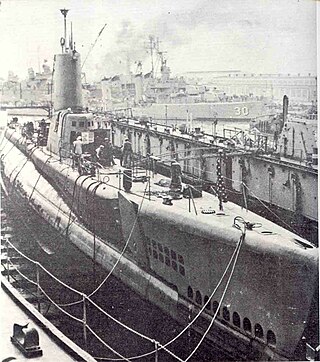
USS Medregal (SS-480/AGSS-480), a Tench-class submarine, was the only ship of the United States Navy to be named for the medregal, a streamlined, fast-swimming, bluish-colored fish of the jack family which abounds in waters of the West Indies and in the Atlantic as far north as the Carolinas.

USS Goldsborough (DD-188/AVP-18/AVD-5/APD-32) was a Clemson-class destroyer in the United States Navy during World War II. She was the second Navy ship named for Rear Admiral Louis M. Goldsborough (1805–1877). Entering service in 1920, the ship had a brief active life before being placed in reserve in 1922. Goldsborough was reactivated for World War II and was used as an aircraft tender, destroyer and high speed transport in both Atlantic and Pacific theaters. Following the war, the ship was sold for scrapping in 1946.

USS Towhee (AM-388) was an Auk-class minesweeper acquired by the United States Navy for the dangerous task of removing mines from minefields laid in the water to prevent ships from passing.

USS Turkey (AMS-56/YMS-444) was a YMS-135 subclass of YMS-1-class minesweepers built for the United States Navy during World War II.

USS Brant was a YMS-1-class minesweeper built for the United States Navy during World War II.

USS Sanderling (AMS-35/AMCU-49/MHC-49/YMS-446/PCS-1393) was the lead ship of her subclass of YMS-1-class minesweepers built for the United States Navy during World War II.

USS Kingfisher (AM-25/AT-135/ATO-135) was an Lapwing-class minesweeper acquired by the U.S. Navy for the dangerous task of removing mines from minefields laid in the water to prevent ships from passing.
USS PCS-1465 was a PCS-1376-class minesweeper built for the United States Navy during World War II. Late in the war she was renamed and reclassified Minah (AMc-204), and in the 1950s reclassified first as AMCU-14 and later as MHC-14. Named for the myna under a variant spelling, she was the only U.S. Navy ship of that name.

USS Magpie (AMS-26/YMS-400) was a YMS-1-class minesweeper of the YMS-135 subclass built for the United States Navy during World War II.

USS Grouse (AMS-15/YMS-321) was a YMS-1-class minesweeper of the YMS-135 subclass built for the United States Navy during World War II.

USS Waxbill (MHC-50/AMCU-50/AMS-39/YMS-479/PCS-1456) was a YMS-1-class minesweeper of the YMS-446 subclass acquired by the U.S. Navy for the task of removing mines placed in the water to prevent ships from passing.
USS Cardinal was a YMS-1-class minesweeper of the YMS-135 subclass built for the United States Navy during World War II. She was the third ship in the U.S. Navy to be named for the cardinal.
USS Linnet (AMS-24/YMS-395) was a YMS-1-class minesweeper of the YMS-135 subclass built for the United States Navy during World War II.

USS Kite was a YMS-1-class minesweeper of the YMS-135 subclass built for the United States Navy during World War II.

USS Jacob Jones (DE-130) was an Edsall-class destroyer escort built for the U.S. Navy during World War II. She served in the Atlantic Ocean and provided destroyer escort service against submarine and air attack for Navy vessels and convoys.

USS Lorikeet (AMS-49/YMS-271) was a YMS-1-class minesweeper of the YMS-135 subclass acquired by the U.S. Navy for the task of removing mines from water that had been placed there to prevent ships from passing.

USS James M. Gilliss (AMCU-13/YMS-262) was a YMS-1-class minesweeper of the YMS-135 subclass named after James Melville Gilliss, a US naval officer credited with establishing the US Naval Observatory.

USS Rhea (AMS-52/YMS-299) was a YMS-1-class minesweeper of the YMS-135 subclass acquired by the U.S. Navy for the task of removing mines that had been placed in the water to prevent ships from passing.

USS Redhead (AMS-34/YMS-443) was a YMS-1-class minesweeper of the YMS-135 subclass built for the United States Navy during World War II. She was the first U.S. Navy ship to be named for the Redhead duck.

USS Swallow was a YMS-1-class minesweeper of the YMS-446 subclass built for the United States Navy during World War II. She was originally laid down as PCS-1416, and, when renamed later in her career, became the third U.S. Navy ship named for the swallow.














